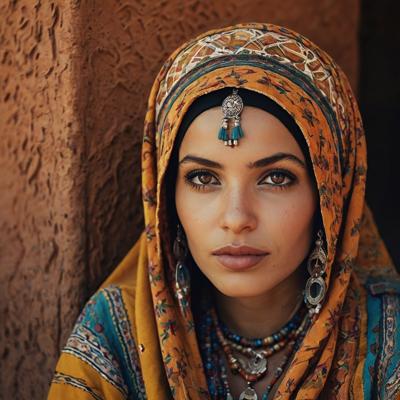Moroccan Desert Adventures
Guide to Sahara tours, Merzouga, camel rides, and desert camps.
The Sahara Desert towered over me, a never-ending stretch of golden dunes lit by a sky so big it seemed to be able to swallow me whole. During my first camel trek in Merzouga at 19, I rode a dromedary as the sun set and the sand turned rose and amber. A lifelong passion for Morocco’s desert—a place where time stands still, stars shine, and every experience seems to be a tale from a thousand years ago—was ignited by that moment decades ago. I’m here to help you navigate the magic of Moroccan Desert Adventures as a native of Marrakech who has travelled to the outskirts of the Sahara from Erg Chebbi to Erg Chigaga. This guide will assist you in organising a wonderful trip, whether your dreams include an exciting 4×4 desert adventure in Morocco, an overnight stay in a desert camp, or the ideal sunrise and sunset in the Sahara.
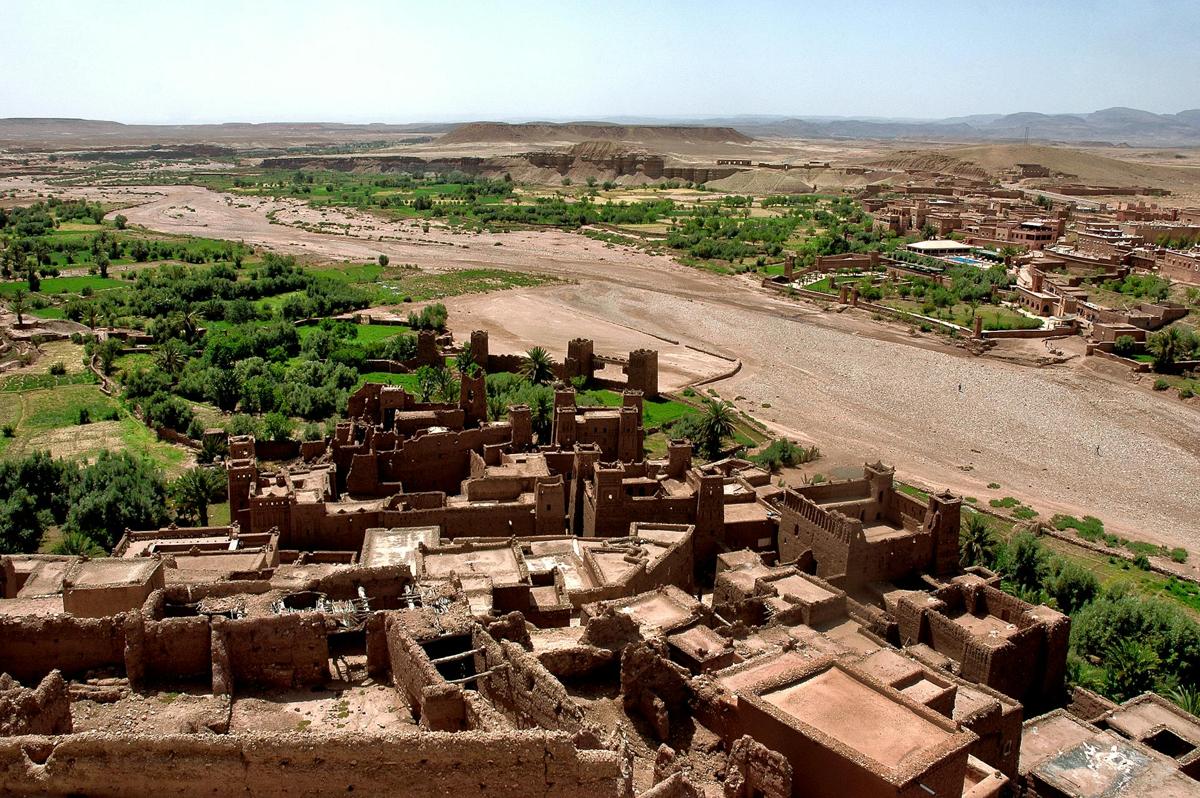
In the Sahara, timing is crucial. Spring (March–May) or fall (September–November) are the ideal seasons to visit the Moroccan Desert because of the pleasant temperatures, which range from 20–30°C (68–86°F) during the day and cool off at night.
During my April visit, I woke up to a clear morning with the dunes glistening in the soft sunlight, ideal for early hikes or stargazing in the Moroccan Sahara. While winter (December–February) brings cold nights that occasionally drop below freezing, summer (June–August) can reach 45°C (113°F), making daytime activities taxing.
While families may prefer the pleasant weather of fall for desert tours with children, spring’s wildflower blooms add a touch of magic for romantic desert getaways for couples.
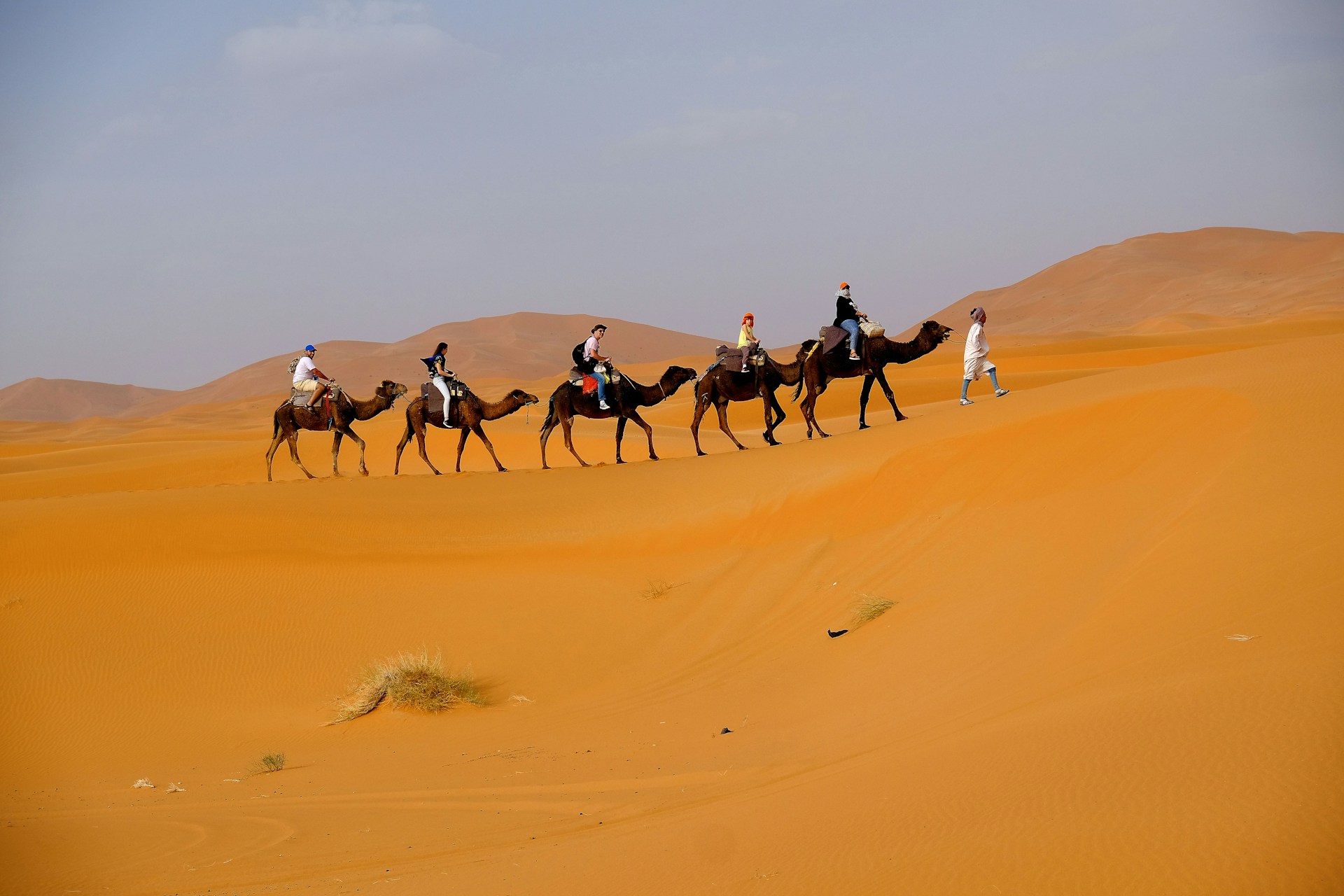
The journey to the Sahara is a unique adventure. Most tourists depart from Marrakech or Fes, with Marrakech as the starting point for the best tours of the Sahara Desert. It takes nine to ten hours to drive from Marrakech to Merzouga, where Erg Chebbi is located, and roughly seven hours to drive to Zagora, which is close to Erg Chigaga. I’ve travelled both paths, which meander through the breathtaking passes of the Atlas Mountains, past oases fringed with palm trees, and into the edge of the desert. Rental cars, shared minivans, and private tours are common choices. Choose a 2-day desert tour over a 3-day one for a more seamless experience; the latter allows you more time to see places like Ait Benhaddou or the Draa Valley and its desert oases.
How does one go about making an online reservation for a desert tour? Websites like GetYourGuide and regional companies like Morocco Desert Tours provide reliable options; however, read reviews to avoid desert tourist traps.
Pro tip: Confirm in advance the inclusion of items such as meals and camel rides.

Choosing between Erg Chebbi and Erg Chigaga depends on your vibe. Erg Chebbi, near Merzouga, is the more accessible and iconic choice, with towering dunes reaching 150 meters.
My first overnight stay in a desert camp was here, where I slept in a Berber tent under a sky with stars. It’s perfect for luxury vs budget desert tours in Morocco—you’ll find everything from basic camps to glamping with private bathrooms. Erg Chigaga, near Zagora, is wilder and more remote, requiring a 4×4 to reach.
I once spent a night there, far from light pollution, feeling like the only soul for miles. It’s ideal for adventurers seeking solitude or solo travel in the Moroccan Desert. Erg Chebbi suits first-timers and families, while Erg Chigaga is for those craving an off-the-grid experience.

Merzouga camel trekking is the epitome of Moroccan Desert Adventures. Imagine yourself balancing on top of a camel as it lumbers through the golden dunes of Erg Chebbi, the only sound disturbing the stillness being the crunch of sand. Camels are gentle but unyielding animals, and my first trek years ago was both exhilarating and humbling. Most tours conclude with dinner, traditional music, and dancing at a desert camp after one to two hours.
What should I bring on a Moroccan desert vacation? Sand gets everywhere, so wear sturdy shoes, a dust scarf, and lightweight, long-sleeved clothes. Bring cash for tips, but guides take care of everything.
Shorter hikes are available for families with children on desert tours, and some camps allow children as young as five to ride camels.
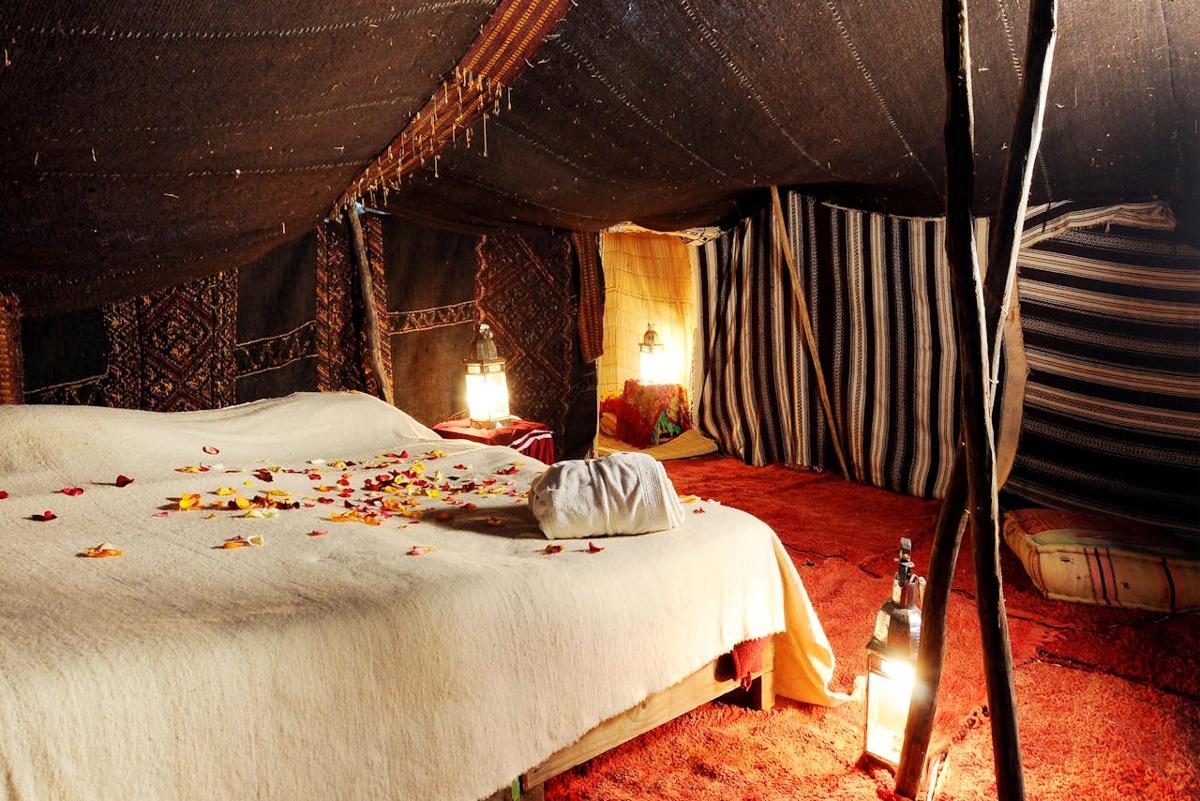
An overnight in a desert camp is the heart of any Sahara trip. After a camel trek, you’ll arrive at a cluster of Berber tents, ranging from basic setups with shared facilities to luxury desert tours in Morocco with private tents, hot showers, and plush bedding. I remember my first night, gathered around a campfire, eating local cuisine in the Moroccan Desert—a hearty tagine of lamb and dates—while Berber drummers played under the stars. Expect simple but delicious meals, communal dining, and stargazing in the Moroccan Sahara that rivals any planetarium.
Health and safety tips for the desert: Stay hydrated, wear sunscreen, and pack layers for cold nights. Camps often lack electricity, so a portable charger is a must.

For thrill-seekers, 4×4 desert excursions in Morocco are an exciting experience. I went to one in Erg Chigaga, where the driver bounced over dunes in a Land Rover and expertly handled the shifting sands. These journeys often make stops at nomadic villages or oases, offering a glimpse into the history of Morocco’s desert nomads. You may encounter a Berber family, as I did, who are sharing tea and stories about their desert forebears. Tours ranging from half-day outings to multi-day expeditions usually include sandboarding in Morocco’s dunes.
Which drones work best for taking pictures of the Sahara? A DJI Mini is a good option for aerial shots, but to ensure safe vehicles and knowledgeable drivers, check local regulations and book with reputable operators.

Sandboarding in Morocco’s dunes is an absolute blast. While strapping on a board and sliding down a dune with sand flying everywhere, I tried it in Erg Chebbi. With guides offering boards and fundamental instruction, it’s easy for beginners. The hotspot is Merzouga, but it’s also in Zagora.
To protect yourself from sand, put on sunglasses and closed-toe shoes. Although younger children may require supervision, it’s a popular destination for families with children on desert tours.
Add it to a Saharan sunrise and sunset for a full day of exploration—I still remember a recent trip where I watched the sun rise over the dunes.

The night sky over the Sahara is breathtaking. In the Moroccan Sahara, where there is no light pollution, stargazing is like looking into the soul of the universe. I have seen constellations and even the hazy band of the Milky Way while lying on a dune. Locals point out Berber star lore during guided stargazing, available at many camps. For a more profound experience, bring binoculars or a star map app.
Advice for taking pictures of desert landscapes: Use a tripod for long-exposure images of the stars; for golden dune colours, take your photos at twilight. A private stargazing session with tea and a blanket is the ultimate romantic desert retreat for couples.
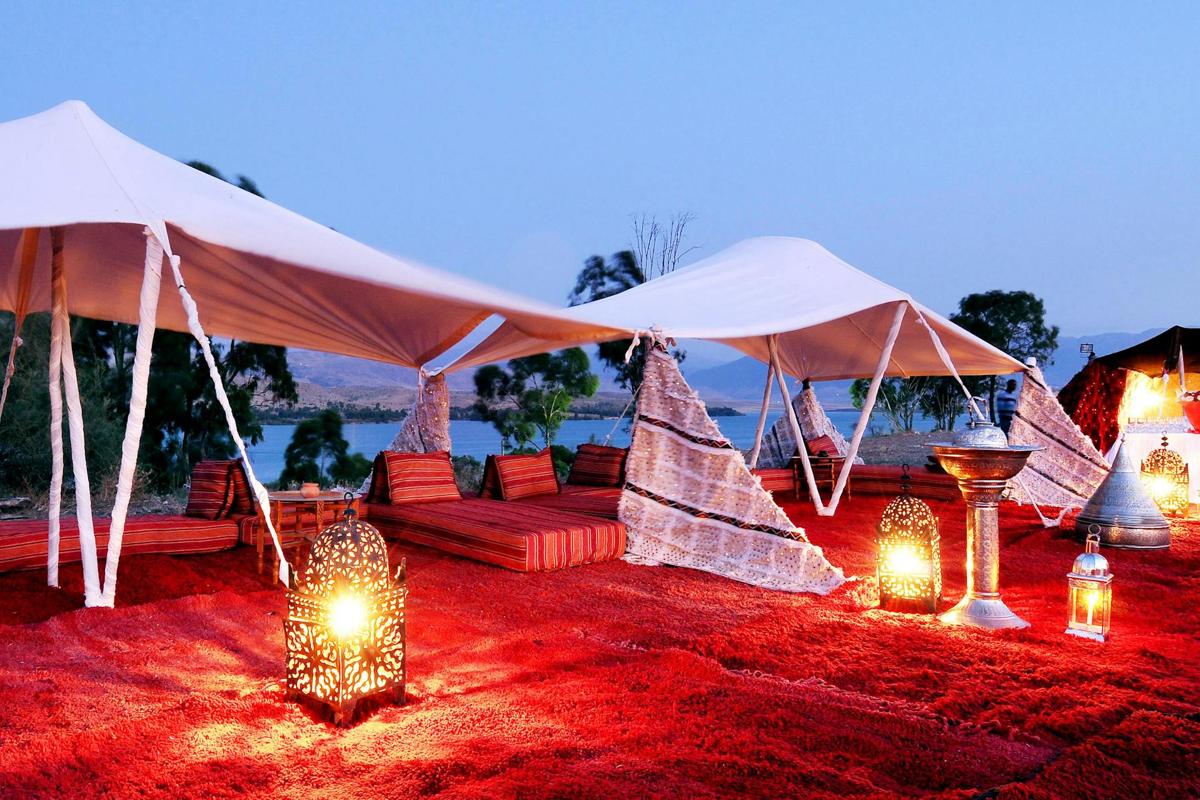
The Sahara accommodates all price ranges. A shared two-day desert tour with meals, camel treks, and basic camps costs between $50 and $100 per person. I have participated in these tours while enjoying the rustic charm of communal tagines and basic tents. With prices ranging from $200 to $500, luxury desert tours in Morocco provide gourmet meals, private tents, and extras like private 4x4s or hot showers. I once enjoyed a candlelit dinner under the stars at a luxurious camp in Erg Chebbi, ideal for romantic desert retreats for couples.
Tips for avoiding desert tourist traps: Make reservations through reputable companies, steer clear of extremely low prices, and ensure everything is included, such as transportation or activities.

The Sahara is more than just sand; it is living. Morocco’s desert fauna includes elusive sand cats and fennec foxes, which are distinguished by their large ears. I saw a desert hedgehog scuttling by on a hike close to Zagora, an uncommon sight. Migratory species such as desert sparrows will be of interest to birdwatchers.
The secret to eco-friendly desert travel is to stay on designated routes to preserve delicate ecosystems.
Frequently, guides can identify wildlife without upsetting it. If you enjoy travelling alone in the Moroccan Desert, bring binoculars and a journal to document sightings.
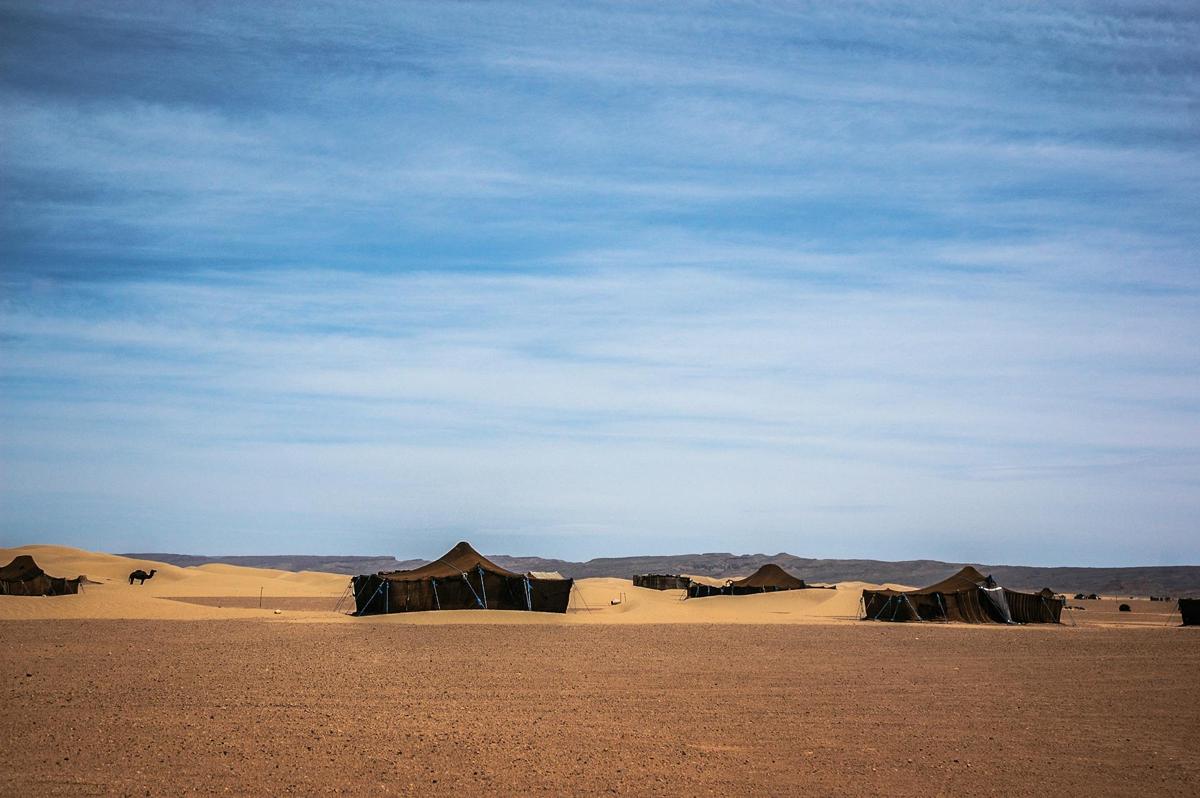
The Sahara significantly influences Moroccan desert nomads’ history. Berber tribes have been wandering these sands for centuries, trading goods and stories. I once discussed with a nomadic family near Erg Chigaga how they rely on the stars to lead and sustain them in such a harsh environment.
Like those in the Draa Valley, their desert architecture and mud-brick kasbahs are architectural wonders integrated into the natural environment.
Often included in 4×4 desert excursions, a visit to a nomadic village shows their hospitality and tenacity.
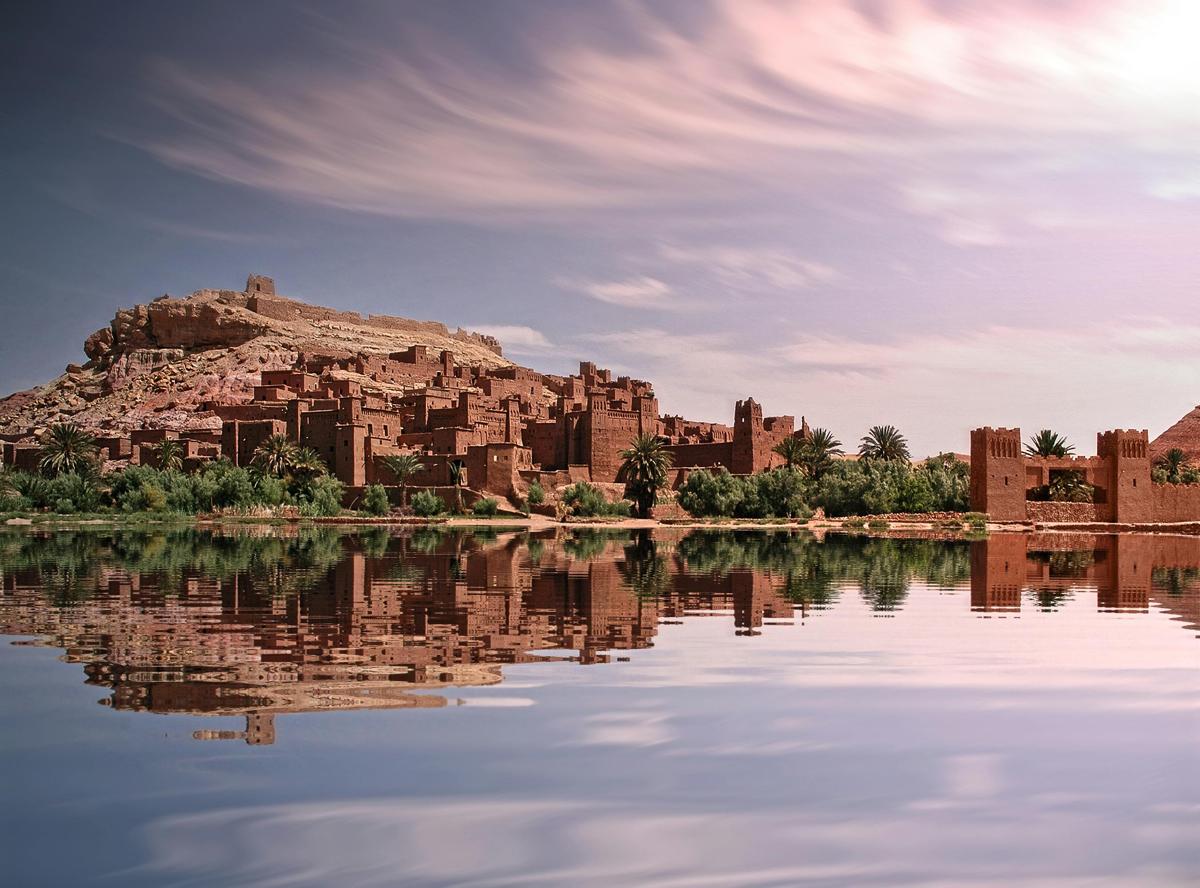
Kasbahs and other desert architecture can be found scattered throughout Morocco’s desert. These mud-and-straw fortified houses are both aesthetically pleasing and functional. One beautiful example is Ait Benhaddou, a UNESCO site close to Ouarzazate; I’ve explored its alleys and imagined what it would have been like to be a trader in the 16th century. There are kasbahs like Tamnougalt in the Draa Valley and its desert oases, where you can spend the night. Their geometric patterns and earthy hues are a photographer’s paradise.
Advice for taking pictures of desert landscapes: Use a polarising filter to capture the textures of the kasbahs and shoot in soft light at dawn or dusk.
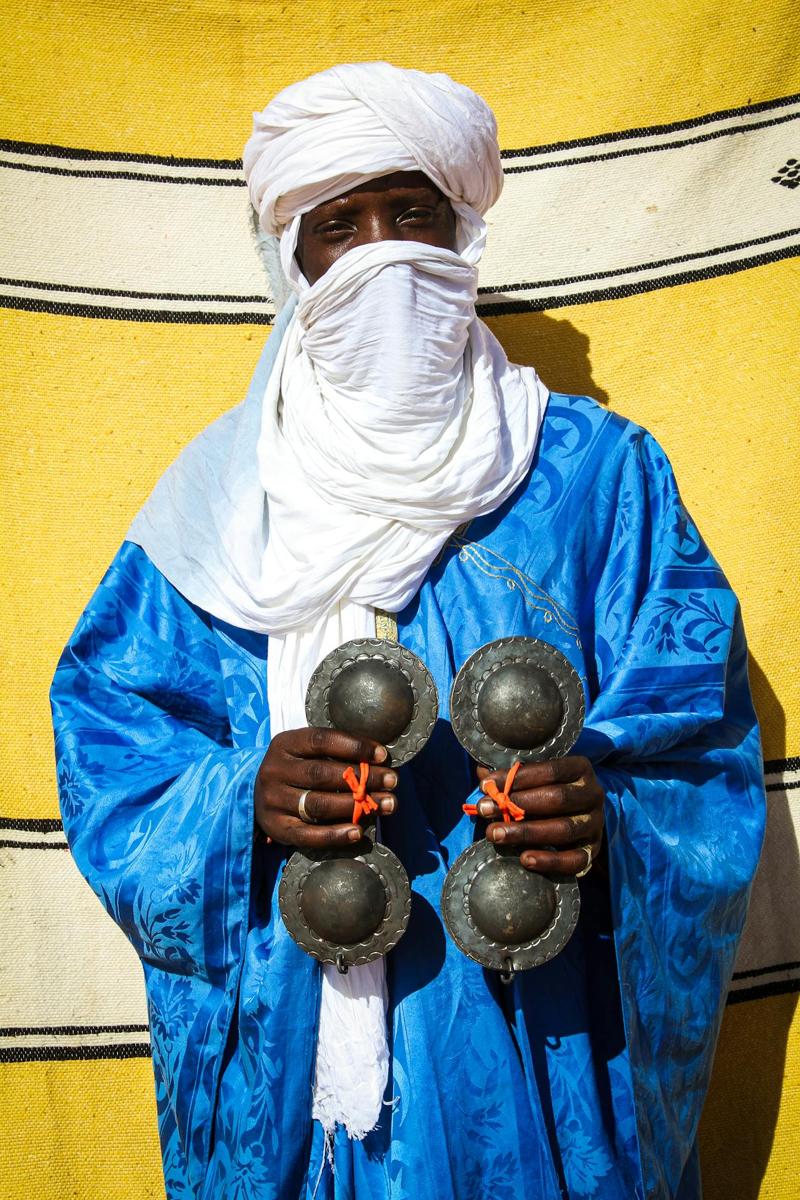
After a day in the dunes, traditional dance and music in desert camps enliven the evening. The sands echo with the sounds of Berber drummers and Gnaoua musicians. As I’ve danced under the stars to the beat of a tam-tam drum, I’ve felt a connection to centuries of tradition.
Dinner performances at specific camps frequently include local Moroccan desert cuisine, such as couscous or rfissa. Since kids love music and some camps teach drumming, these evenings are popular for family desert tours.

Local cuisine in the Moroccan Desert is a highlight. Expect slow-cooked tagines, often lamb or chicken with dried fruits, served with fresh bread. In a Zagora camp, I savoured a vegetable tagine spiced with saffron and sweet mint tea.
Desert markets and souvenirs near camps sell spices and dates—perfect for recreating the flavours at home.
For health and safety tips for the desert, avoid raw foods and stick to bottled water. Vegetarians will find options, but confirm with your camp in advance.
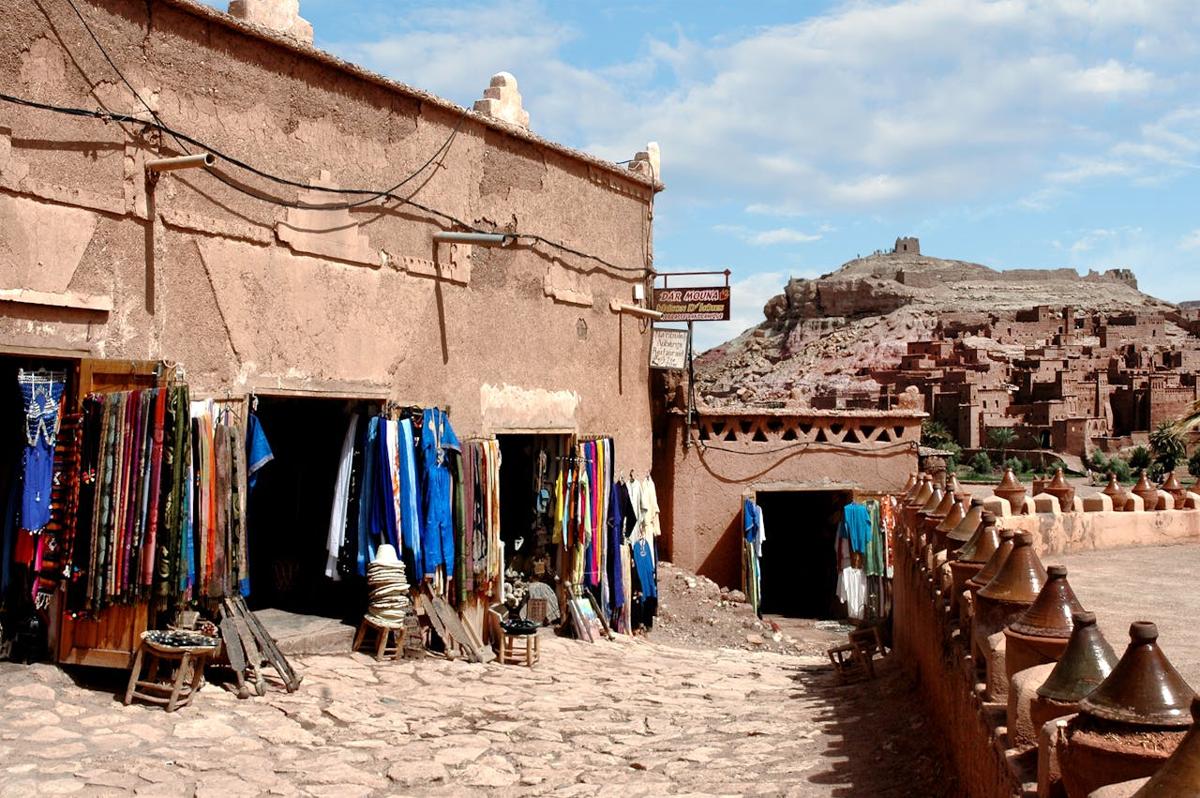
Souvenirs and desert markets give your trip more colour. Roadside stalls in Merzouga sell turquoise jewellery, Berber rugs, and fossils. At a Zagora market, I purchased a handwoven scarf from a vendor who told me about the threads’ desert dyeing.
Choose genuine crafts over mass-produced trinkets and haggle politely.
Look for cooperatives or markets in towns like M’hamid or Tamegroute, as eco-friendly desert tourism encourages the support of local artisans.

For thrill-seekers, the Moroccan Desert on a motorcycle is epic. I’ve ridden through the Draa Valley, the wind whipping past as palms and kasbahs blurred by. Guided motorcycle tours, like those from Morocco Bike Adventures, combine desert trails with stops at oases or nomad camps. You’ll need experience—sandy terrain is tricky.
Health and safety tips for the desert: Wear protective gear, stay hydrated, and follow guided routes to avoid getting lost. It’s not for everyone, but the freedom is unmatched.

Eco-friendly desert tourism is vital for preserving the Sahara. Choose operators who minimize environmental impact, like those using solar-powered camps or limiting vehicle use. I’ve stayed at camps like Azalai Desert Lodge, which supports local communities and uses sustainable practices. Avoid littering, stick to marked paths, and respect wildlife.
For solo travel in the Moroccan Desert, eco-conscious tours offer a chance to connect with the land responsibly.
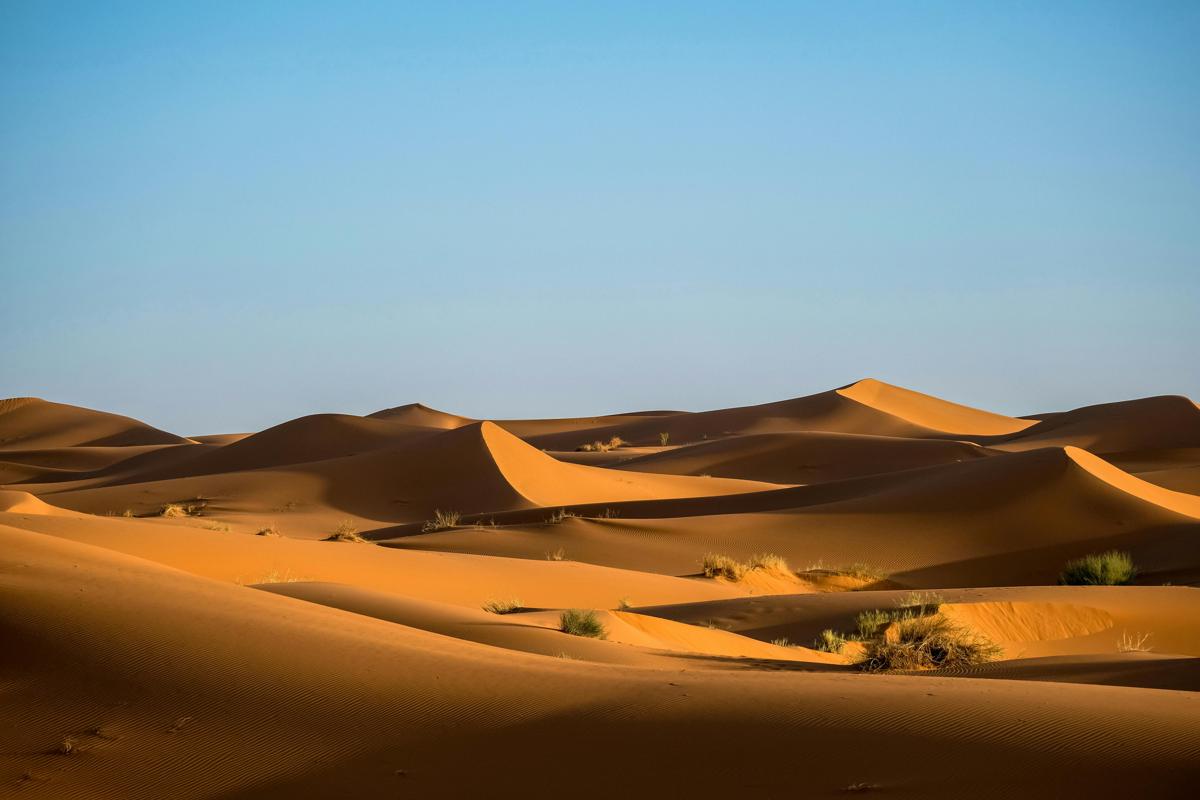
The Sahara is a photographer’s dream come true. Advice for taking pictures of desert landscapes: If you want warm, soft light, shoot in the golden hours (dawn and dusk). A telephoto lens works well for far-off kasbahs or wildlife, while a wide-angle lens captures the vastness of the dunes. I used a tripod to steady my camera to get clear dune silhouettes when I took a sunrise and sunset photo in the Sahara.
Which drones are ideal for photographing the Sahara? The DJI Mavic Air and other small models are excellent, but always check with your guide about local drone regulations.

The Sahara is made for couples to have romantic desert getaways. Picture a private dinner under the stars, a camel trek for two, or a luxury tent with rose petals on the bed.
I surprised my husband with a Merzouga getaway, and the quiet of the dunes felt like our own world. Book a private camp or a high-end tour for intimacy.
Stargazing in the Moroccan Sahara adds a magical touch—bring a blanket and cuddle up.

Health and safety precautions are essential because the desert is harsh. Wear sunscreen with an SPF of 50, drink two to three litres of water daily, and cover up with long, light clothing. After a trek that resulted in sunburn, I learned these critical safety precautions firsthand! Steer clear of the midday heat and bring basic first aid supplies like bandages and rehydration salts.
For the system: When travelling solo in the Moroccan Desert, inform your accommodation or tour operator of your plans, and always travel with a guide in remote areas.
FAQs About Moroccan Desert Adventures
Four questions to ask
Question 1
What’s the difference between a 2-day and a 3-day desert tour?
A 2-day vs a 3-day desert tour depends on your schedule. A 2-day tour from Marrakech to Merzouga is rushed but covers the basics: a camel trek, camping overnight, and key stops like Ait Benhaddou. A 3-day tour provides additional time for exploring the Draa Valley, visiting villages, or enjoying leisurely dune time. I recommend 3 days for a fuller experience.
question2
Is the desert safe for families with kids?
Yes, desert tours for families with kids are widely available. Opt for shorter camel rides and family-friendly camps with amenities like toilets and shaded areas. Merzouga camps often have activities like sandboarding, which kids love. Bring snacks and games for long drives.
QUESTION3
How do I avoid tourist traps?
Tips for avoiding tourist traps in the desert: Book with reputable operators (check TripAdvisor or Lonely Planet reviews), avoid deals that seem too cheap, and clarify inclusions like meals, transport, or activities. Local guides, often Berbers, offer authentic experiences—ask your riad for recommendations.
QUESTION4
What’s the best way to capture the desert?
For photography tips for desert landscapes, shoot at dawn or dusk, use a tripod, and experiment with angles to capture dune textures. Best drones for capturing the Sahara include lightweight models, but always check local regulations. For stargazing in the Moroccan Sahara, a long-exposure camera setup is ideal.
A Desert Journey to Remember
The Sahara is not just a destination; it is an experience. Every moment is an adventure waiting to be unearthed, from the exhilaration of sandboarding in Morocco’s dunes to the rhythm of traditional music and dance in desert camps. I can promise that the desert will amaze, challenge, and last a lifetime after living in Morocco for 48 years. This trip will enthral you, whether you explore kasbahs and desert architecture, eat local cuisine in the Moroccan desert, or chase sunrises and sunsets in the Sahara. Bring your sense of awe, pick a tour that interests you, and let the Sahara captivate you.
Listen to this Article
For our readers who like to listen on the go or need accessibility, here’s the full audio:

